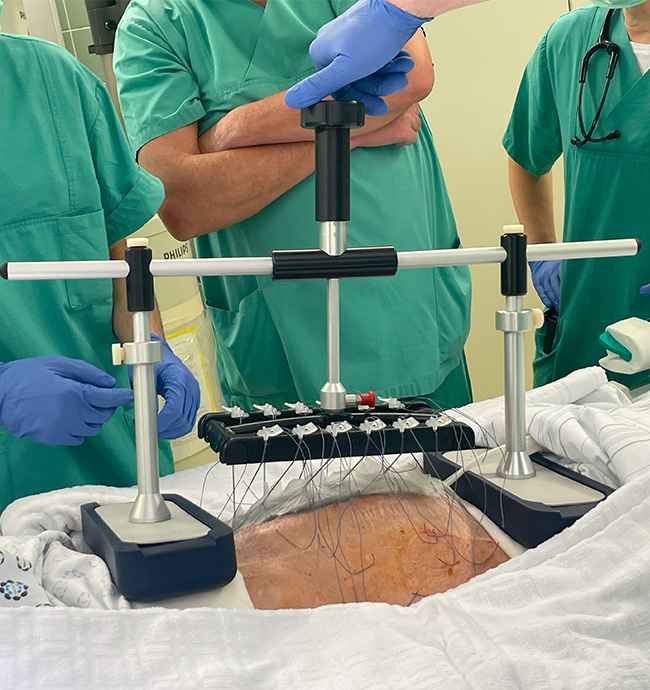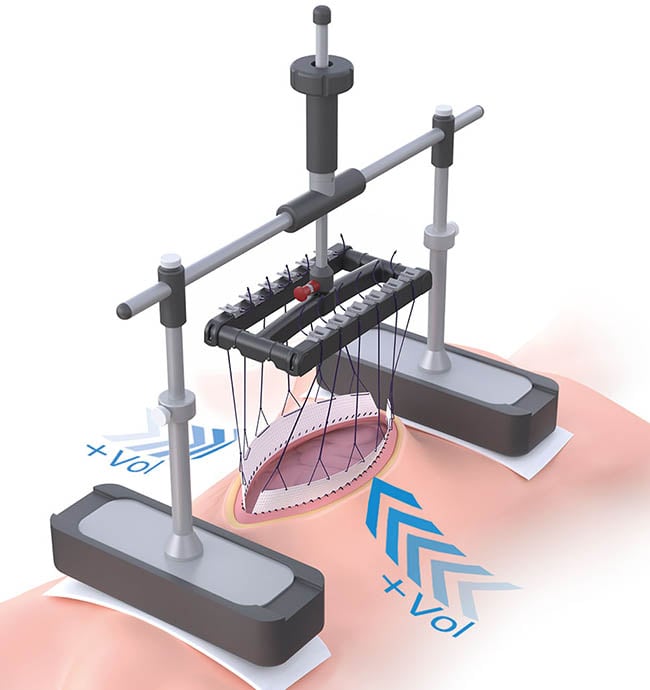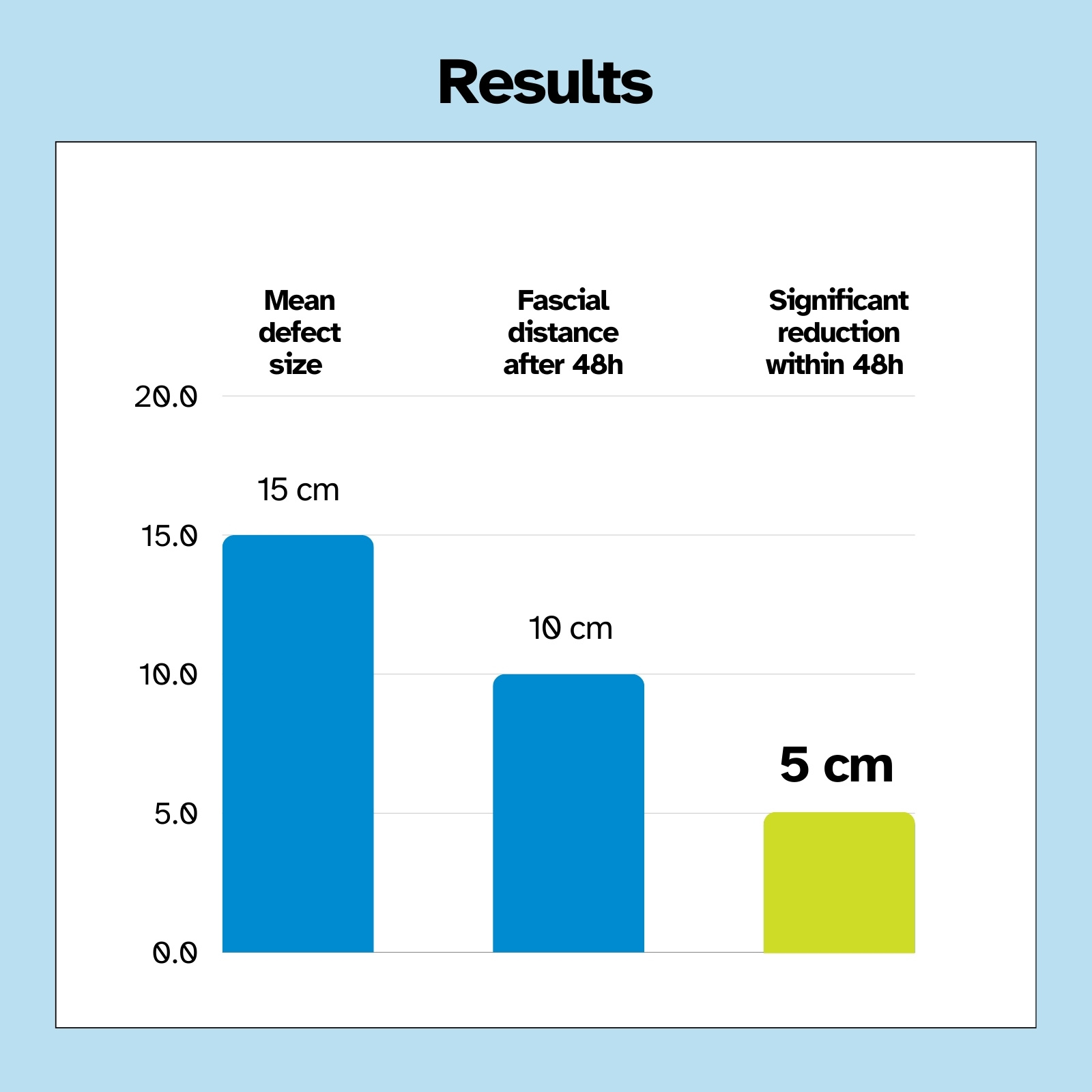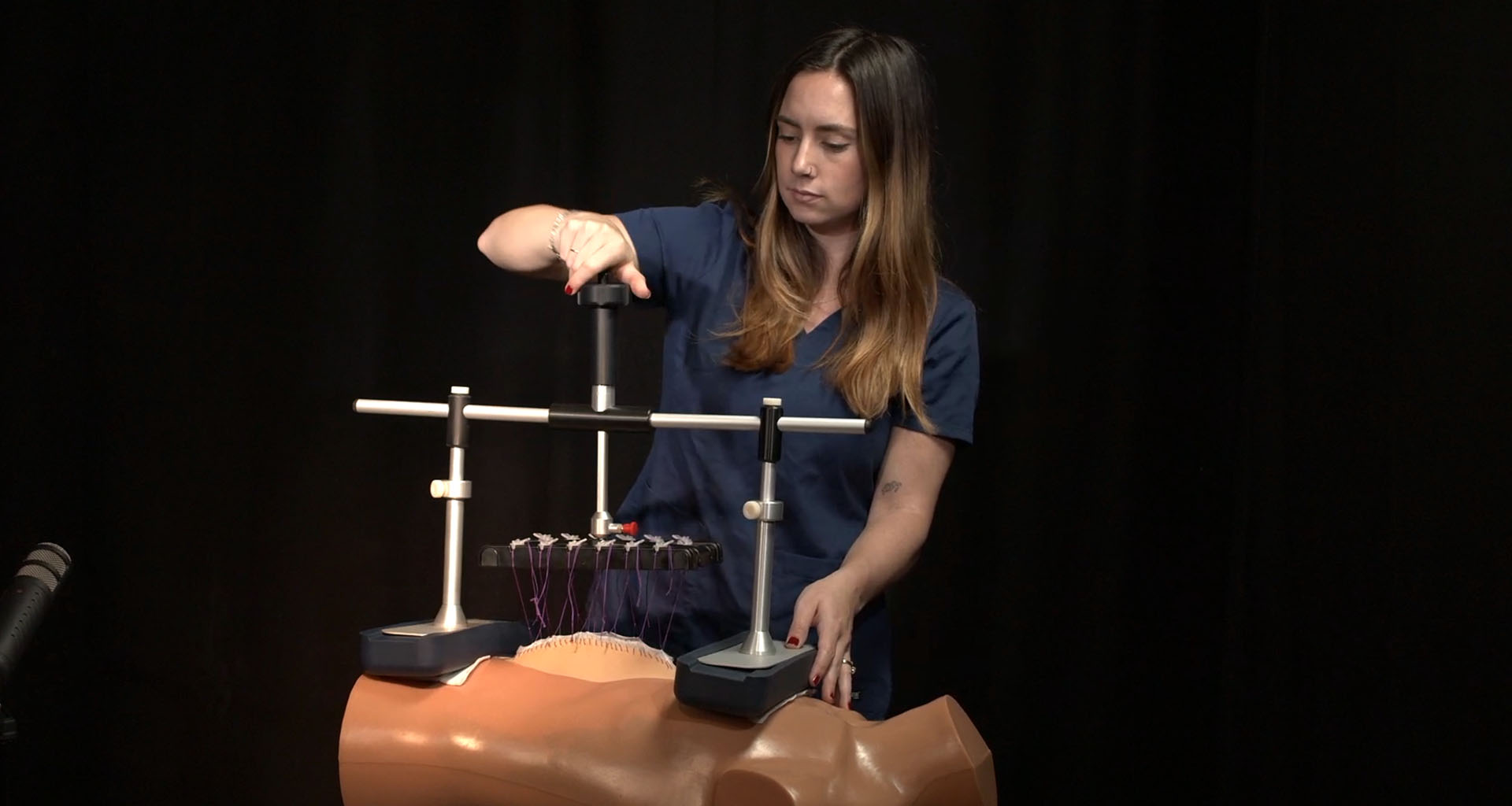fasciotens®Abdomen Change your direction of open abdomen treatment
Leaving an abdomen open is often a necessary and life-saving measure. However, this kind of therapy comes with various challenges. Many of these can be overcome by applying vertical traction to the abdominal wall. Learn how and why our solution can improve your patient's condition and therapy outcome.


Revolutionizing open abdomen therapy
What makes the difference using the fasciotens® solution?
Preventing abdominal wall retraction
By applying immediate vertical traction to the abdominal wall, the retraction of the lateral abdominal muscles can be prevented. Especially during the early stage of open abdomen treatment, horizontal traction cannot be sufficiently applied. In contrast, vertical traction is applicable from the beginning, regardless of the extent of the intestinal edema, and ultimately accelerates the final closure of the abdominal wall at the end of the treatment.
Stabilizing the patient*
The technique of applying vertical traction to the abdominal wall increases the intra-abdominal volume. Enlarging the abdominal cavity leads to lower intra-abdominal pressure ( IAP) which is one of the major factors for stabilizing the patient.
Easy integration into daily ICU routines
The device was designed to be used hassle-free in the ICU. It can be disassembled and assembled within seconds for emergencies or patient care. Educating the ICU team is a vital part of our onboarding process. We make sure to support you in the best way possible.
Seamless combination with NPWT
fasciotens® can be combined easily with other techniques like negative pressure wound therapy (NPWT). We have prepared a step-by-step guide to applying the wound dressing.
Register for our e-learning to access all training material for the abdomen device
How does it work?
Vertical traction is the solution to succeed in open abdomen treatment
The fasciotens®Abdomen device applies controlled vertical traction to the abdominal wall. It increases the volume of the abdominal cavity and thus reduces the intra-abdominal pressure. This can have beneficial effects on lung function, organ perfusion and renal output*.
Additionally, the device prevents fascial retraction, facilitating direct closure after the oedema decreases. Revision surgeries or "planned" incisional hernias become much less likely.
Support
Learn more about fasciotens®Abdomen

Publications
Vertical traction device prevents abdominal wall retraction and facilitates early primary fascial closure of septic and non‑septic open abdomen
Langenbecks Arch Surg 407, 2075–2083 (2022)
First retrospective multicenter study on fasciotens®Abdomen showing promising results and demonstrates safety and feasibility of the device.
- 100% successful early closure
- After 48h: Fascial distance significantly decreased
- Mean of 7 days for definitive fascial closure
- 0% mortality

Case Report
Open Abdomen Treatment after Peritonitis
fasciotens®Abdomen was applied early on a patient after an emergency surgery. The results show how the patients benefit from immediate vertical fascial traction during the open abdomen treatment.
Frequently Asked Questions
Why shouldn't I stick to mesh-mediated horizontal traction?
Open abdomen therapy lowers the intra-abdominal pressure and resolves abdominal compartment syndrome. By opening the abdomen you increase the volume in the abdominal cavity. Applying horizontal traction helps to prevent fascial retraction but lowers the intra-abdominal volume which can increase the intra-abdominal pressure again. Therefore, you normally have to wait until the intestinal edema and swelling have decreased to a level that allows the use of horizontal mesh-mediated traction. In the meantime, the lateral abdominal wall muscles retract.
Can you combine the fasciotens®Abdomen therapy with other techniques?
Absolutely! Depending on the patient's condition different techniques can or should be added to our therapy. In many cases, vertical fascial traction is combined with abdominal negative pressure wound therapy.
What's the procedure for my first application?
Just reach out to your local fasciotens partner or directly to us. One of our surgeons or fasciotens® specialists will discuss your case with you and together we agree on whether fasciotens® is suitable. We will make sure that you will have a fasciotens® expert at your side during the treatment and also train the staff in ICU comprehensively.
How long does the treatment last with fasciotens®Abdomen?
That depends largely on the patient's condition.
If the patient stabilizes quickly, fascial closure is directly possible.
Normally it lasts several days, sometimes even weeks. The device will be applied either in the OR or in ICU.
How does fasciotens®Abdomen fit in the daily routine in ICU?
The ICU team will be trained thoroughly by our fasciotens® experts. They can perform all their daily tasks as usual.
Hundreds of successful applications
Surgeons' opinions on fasciotens®Abdomen
"The results are impressive: The 12 cm fascial gap was closed tension-free. The patient was mobilised at the ward within a week - without the primary abdominal wall closure he would otherwise have remained in bed much longer ."

Dr. Thomas Mones
Senior Consultant, Specialist in colorectal Surgery & Head of the Hernia Center, Brilon
"As part of a small feasibility study (n=9), the system was even used for complex abdominal incisions. Multiple traction cycles promote approximation of the fascia. The device can be used comfortably in ICUs, also in combination with Negative Pressure Wound Therapy (NPWT). It's certainly an improvement for these highly complicated cases."

PD Dr. Burkhard Stoffels
Head of department for general surgery, Cologne
"Open abdomen occurs particularly after aortic rupture (incidence 10-20%). In these patients, decreasing the pressure on the abdominal organs is essential. The fasciotens device is, as far as I know, the only approach that can guarantee this mechanism."

Prof. Eike Sebastian Debus
Director of the department of Vascular Medicine, Hamburg
Caterina Ladeira successfully applied fasciotens®Abdomen on conjoined twins:

Watch the 20-minute e-learning course about fasciotens®Abdomen
Join this course for a quick introduction on applying the fasciotens®Abdomen device during surgery and in the ICU afterwards.
*Sources
- Fung, S., Ashmawy, H., Krieglstein, C. et al.: "Vertical traction device prevents abdominal wall retraction and facilitates early primary fascial closure of septic and non‑septic open abdomen", Langenbecks Arch Surg 407, 2075–2083 (2022)
- Mavc, Z., Kunst, G.: "Fasciotens©Abdomen system application for delayed primary fascial closure and observed physiological improvement of the patient", Surgery Surg Endos 2023; 5(1) Suppl. 2: 62-67





